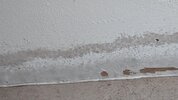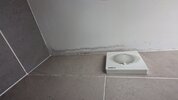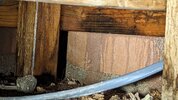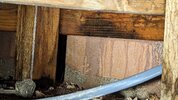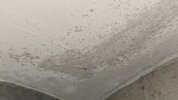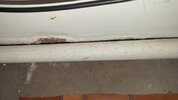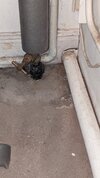Trying, still, to resolve a leak beneath a shower. It was leaking badly and have resealed it all including bits that were poorly fitted, but still an area of timber beneath the shower tray continues to be soaking. It's almost like it's saturated with moisture coming *through* the 2x4 timber which supports the shower tray, and is screwed into the wall which is an external cavity wall.
Apart from the shower tray immediately above that timber there are no pipes that could be responsible. On the ceiling above the timber there is a odd patch on the ceiling. I'd presumed this is condensation but now I'm wondering if it could in fact be a leak.
Does the photo pattern show more like condensation or a leak? Condensation I would have expected to be darker, leak I would have expected more widespread. Drilled a hole and the plaster was dry.
Ceiling construction is plasterboard - 100mm celotex - void - original ceiling - 100mm rockwool - void and central heating pipes - 18mm chipboard. Above that is eaves as it's a bungalow and that's a downstairs shower.
Incidentally the timber is screwed into the wall which is a cavity wall and the timber itself bridges the DPC. We had a lot of rain last night and the shower wasn't used. The timber was wetter this morning than yesterday so if I rule out a ceiling void leak, it's time to open up the cavity I think.
Thanks
Apart from the shower tray immediately above that timber there are no pipes that could be responsible. On the ceiling above the timber there is a odd patch on the ceiling. I'd presumed this is condensation but now I'm wondering if it could in fact be a leak.
Does the photo pattern show more like condensation or a leak? Condensation I would have expected to be darker, leak I would have expected more widespread. Drilled a hole and the plaster was dry.
Ceiling construction is plasterboard - 100mm celotex - void - original ceiling - 100mm rockwool - void and central heating pipes - 18mm chipboard. Above that is eaves as it's a bungalow and that's a downstairs shower.
Incidentally the timber is screwed into the wall which is a cavity wall and the timber itself bridges the DPC. We had a lot of rain last night and the shower wasn't used. The timber was wetter this morning than yesterday so if I rule out a ceiling void leak, it's time to open up the cavity I think.
Thanks


